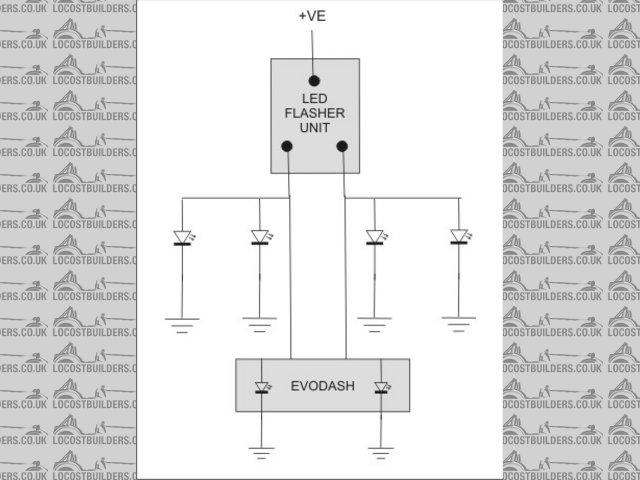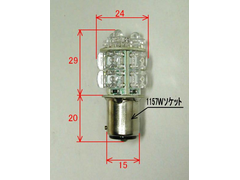RazMan
|
 posted on 7/3/06 at 05:56 PM posted on 7/3/06 at 05:56 PM |

|
|
Odd problem with LED indicators
I have connected up my indicators using a proper LED flasher unit (from Premier Wiring) and everything works perfectly except the warning lamps on the
Evodash don't flash - they come on (and stay on) until the indicator is cancelled.
If I replace one of the LED bulbs with a standard filament bulb the Evodash lights flash ok - it is only staying on when all indicators are LEDs.
A call to Evodash had them puzzled too so no answers there. It must be due to the signal wire staying 'high' in between flashes, keeping
enough power to light the LED permanently.
Has anyone got any ideas? I could put a resistor in parallel with the LED indicators to pull the voltage down a little but that seems a crude way of
solving the problem.
Cheers,
Raz
When thinking outside the box doesn't work any more, it's time to build a new box
|
|
|
|
|
muzchap
|
| posted on 7/3/06 at 06:41 PM |

|
|
I think you'll need a resitor m8.
My indicators shipped with one - apparently they got quite hot - so are mounted on a plate.
I think there's a pic in my archive - if not - I'll dig one out for you and the associated resistor numbers so you can order a couple.
Just mount them behind the dash as I'm planning to do and then forget about them 
------------------------------------
If you believe you're not crazy, whilst everybody is telling you, you are - then they are definitely wrong!
------------------------------------
|
|
|
Bob C
|
| posted on 7/3/06 at 06:45 PM |

|
|
Might be the only way out - sounds like the problem might be the forward voltage of the LED stack meaning they're happy to hang around at 9V or
so without trying to pull the volts down.
Use the highest resistance that works. At 14.4V a resistor below 400ohms is dissipating more than 1/2watt (common resistor power rating)
cheers
Bob
|
|
|
Dusty
|
| posted on 7/3/06 at 06:58 PM |

|
|
You could just add an additional filiament bulb to each circuit, but hidden away somewhere.
|
|
|
caber
|
| posted on 7/3/06 at 07:14 PM |

|
|
Resistor in series is normal way of controlling forward current in LEDs If there is not one in Evodash there ought to be and it probably wants to gu
up in value
Caber
|
|
|
02GF74
|
| posted on 7/3/06 at 08:56 PM |

|
|
quote:
Originally posted by RazMan
I have connected up my indicators using a proper LED flasher unit (from Premier Wiring) and everything works perfectly except the warning lamps on the
Evodash don't flash - they come on (and stay on) until the indicator is cancelled.
If I replace one of the LED bulbs with a standard filament bulb the Evodash lights flash ok - it is only staying on when all indicators are LEDs.
A call to Evodash had them puzzled too so no answers there. It must be due to the signal wire staying 'high' in between flashes, keeping
enough power to light the LED permanently.
Has anyone got any ideas? I could put a resistor in parallel with the LED indicators to pull the voltage down a little but that seems a crude way of
solving the problem.
I am npot fasmiliar with the proper LED flash unit nor the evodash lamps.
Is the ev lamp filament bulb or LED? And is it connected in series with or in parallel with the LED indicators?
It sounds like the warning lamp needs more current - filament buls are lower resistance than LEDS but without knowing the connections, I cannot
explain why the lamp is on; I'd expect it to be off; nor can suggest any fix.
Fitting a resistor is a biut wasteful of power though but sounds like easiest.
|
|
|
RazMan
|
| posted on 7/3/06 at 10:06 PM |

|
|
Thanks for the input guys! 
The solid state LED flasher is a simple affair - just a +ve supply and a load (which can be a single LED or a few hundred up to about 20W in total
load)
The Evodash has a bit of logic circuitry to sense a 'high' on the indicator feed - the threshold for this is evidently set rather low.
muzchap - I think you are referring to a conventional flasher and LED indicators. In your case, a resistor shunt is the only way to make eveything
flash at the correct rate.
Bob C - I think your theory is spot on. I need to pull the 'low' (in between flashes) a little lower still to make the Evodash warning LEDs
turn off.
Dusty - I can't add filament bulbs due to the max loading of the flasher unit. It would be a rather inelegant solution anyway
Caber - wouldn't a series resistor just reduce the light output of the indicators, or do you mean in series with the Evodash LEDs?
02GF74 - I have attached a basic diagram to help describe the setup a little better.
 
Rescued attachment Evodash Indicators.jpg
Cheers,
Raz
When thinking outside the box doesn't work any more, it's time to build a new box
|
|
|
muzchap
|
| posted on 8/3/06 at 12:41 AM |

|
|
RazMan - you are indeed correct - I was being a turkey!
of course - i'm using a sierra flasher with my LED indicators! DOH! 
Good luck with solving it - at least I've ruled out what not to do 
------------------------------------
If you believe you're not crazy, whilst everybody is telling you, you are - then they are definitely wrong!
------------------------------------
|
|
|
MikeRJ
|
| posted on 8/3/06 at 01:08 PM |

|
|
Bob's answer is alost certainly the correct one. Your diagram is possibly a bit misleading as the LED's indicators very probably have 2
or 3 LED arrays in series internaly, raising the forward voltage considerably.
|
|
|
RazMan
|
| posted on 8/3/06 at 01:18 PM |

|
|
Yes, I didn't think about the internal design of the arrays, but the only LEDs that don't flash are the Evodash ones and I am not sure how
they are triggered.
Just for info my LED lights are these ones .....
[Edited on 8-3-06 by RazMan]
 
Rescued attachment 1157_flux1.jpg
Cheers,
Raz
When thinking outside the box doesn't work any more, it's time to build a new box
|
|
|













